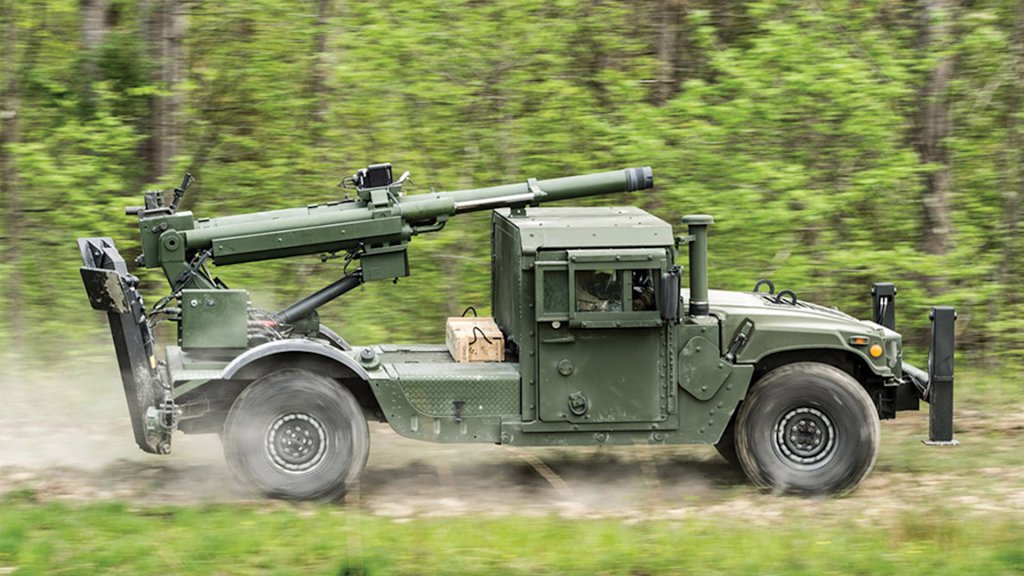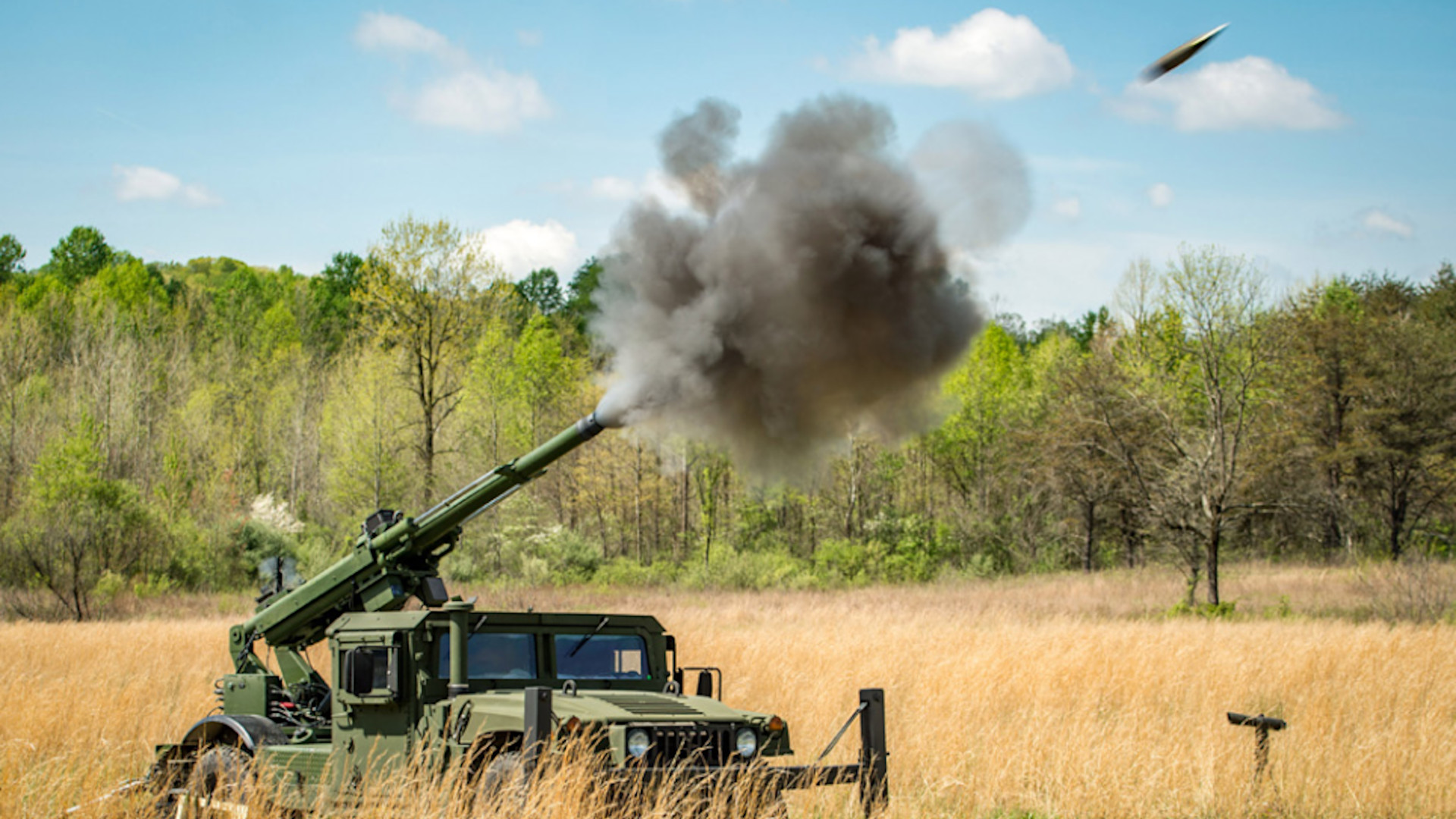The Ukrainian military is set to be one of the first to use a so-called “soft recoil” artillery piece in combat, if it hasn’t already, according to U.S. defense and automotive contractor AM General. The weapon could give Ukraine’s forces a useful new shoot-and-scoot artillery capability. How the self-propelled 105mm low-recoil howitzer performs in Ukraine might have impacts beyond the battlefields there, especially for the U.S. Army, which has had an on-again-off-again interest in weapons of this type.
Mike Evans, AM General‘s Director of Soft Recoil Technologies & Fires Programs, mentioned during a panel talk at the U.S. Field Artillery Association’s Fires Symposium 2024 back in May. His comments only came to wider attention this past weekend after a video, seen below, from the symposium began circulating on social media. Evens does not mention the system in question by name in the clip, but AM General only publicly offers one soft recoil 105mm, the Hawkeye Mobile Howitzer System (MHS), mounted on an up-armored M1152 two-door cargo truck version of the 4×4 Humvee (sometimes referred to as a “2-CT” type).
“I’ll give you a recent experience that we have. We recently put a 105[mm] system into Ukraine. We shipped it … [in] April. … We trained [on] it for two weeks. They immediately went into testing. And that system is destined to be one of the first soft-recoil systems in combat,” Evans said. “It’s going right into combat to test on live targets.”

AM General has been working on the Hawkeye MHS since at least 2016 in partnership with Mandus Group, which developed the howitzer itself. As already noted, Hawkeye’s most notable feature is its soft-recoil system.
The vast majority of modern howitzers feature a recoil mechanism wherein the barrel and breach assemblies move backward to help absorb the force of firing. The platform the weapon is mounted on, whether it be a vehicle or a towed carriage, still typically experiences significant strain in the process. This, in turn, generally precludes lighter vehicles like the Humvee from being used as the chassis for self-propelled howitzers.
Cold War-era U.S. 105mm M101 howitzers, as seen in the video below in use in Ukraine, are an example of a design with a traditional recoil system.

In a soft-recoil system, also sometimes called a “forward-recoiling” or “fire-out-of-battery” system, barrel and breach are held back in some fashion and released when the ‘trigger’ is pulled. The round in the chamber only fires when the entire assembly reaches a certain point and the forward momentum adds to forces counter-acting the resulting recoil.
The video below offers a general look at how Hawkeye functions.

In addition to lower recoil than a comparable howitzer, a weapon of this kind can offer weight savings overall. For comparison, the U.S. Army’s standard 105mm M119 howitzer with its traditional recoil mechanism weighs nearly 4,270 pounds, of which the cannon itself accounts for 1,389 pounds. Mandus Group says Hawkeye, complete with a digital fire control system, tips the scales at 2,550 pounds, with the cannon and breach assemblies together weighing 1,145 pounds.
Hawkeye has a sustained rate of fire of three rounds per minute, but can safely fire up to eight rounds per minute for three minutes, if required, according to Mandus Group. The howitzer uses U.S. standard 105mm ammunition, including the extended-range rocket-assisted M913, a high-explosive type that can hit targets out to just over 12 miles (19.5 kilometers).

Altogether, a system like Hawkeye offers a light, mobile, and flexible artillery package that could be of particular use to Ukrainian forces. Artillery has been and continues to be a key factor on both sides of the battlefield in Ukraine. Russian forces have a much larger total artillery capacity, a disadvantage for Ukraine that has been exacerbated by a major slow-down in U.S. and other Western aid in the past six months or so. The U.S. government has been working to reverse that trend, but this will take time, and lags in foreign military assistance have already had negative impacts on Ukraine’s positions on the battlefield.
Hawkeye’s ability to provide shoot-and-scoot artillery support could also be very valuable given the threats that both sides in the conflict face if they remain in one place for too long. Drones, especially highly maneuverable first-person view kamikaze types, have proven to be a menace to forces on the move let alone ones that remain static for any extended period of time. Unarmed uncrewed aerial systems have also become a pervasive means of finding targets that can then be attacked indirectly in various ways.
“It is very difficult to remain concealed in this environment [in Ukraine]. It is a very contested and congested battlespace,” Under Secretary of the Army Gabe Camarillo said during an online talk the Center for a New American Security think tank hosted in May. “We know that electromagnetic signature[s], the availability of ISR [intelligence, surveillance, reconnaissance] capabilities brought about by these UAVs [uncrewed aerial vehicles], really prevents any forces from being largely concealed or massed together.”
It is worth noting that it is unclear how many Hawkeyes Ukraine has received so far. The comments from AM General’s Evans in May point to just one of these howitzers being provided so far, which would be a very limited new capability. Depending on how the system performs, this could still open the door to more deliveries in the future. It is worth noting here that Ukraine has increasingly become a weapons testing ground, especially for the United States.

Hawkeye’s performance in Ukraine could have significance elsewhere, especially for the U.S. Army, which has tested the weapon in the past. The service has also experimented with a larger 155mm soft-recoil howitzer from AM General and Mandus Group, called Brutus, mounted on a 6×6 Family of Medium Tactical Vehicles (FMTV) cargo truck. So far, the Army has not moved to field either of these systems. Since the 1960s, the Army has tested a number of other soft-recoil howitzers designs as well.

However, on June 1, “the Army Contracting Command-New Jersey” announced it was conducting a new “market survey on behalf of Project Director Tactical Artillery Systems (PD TAS) to identify potential benefits and limitations of soft recoil technologies when applied to 105mm howitzer weapon systems.” That contracting notice “the [U.S.] Government is interested in exploring soft recoil system technologies and applications to the 105mm caliber weapon systems,” but did not elaborate on what underlying requirements or driving factors behind them might be, and stress that there was still not firm intention currently to actually buy any such weapons.
At the Fires Symposium in May, AM General’s Evans did make a comment about how the process of getting the soft-recoil 105mm howitzer to Ukraine and into combat was moving faster than typical U.S. government procedures.
“It’s moving very quickly. There’s no IOT&E at Yuma,” he said, referring to the U.S. military’s initial operational testing and evaluation processes and the U.S. Army’s Yuma Proving Ground in Arizona, which is a major hub for that kind of work.
How the low-recoil 105mm howitzer Ukraine has received from AM General performs in combat remains to be seen. The weapon could offer Ukrainian forces a useful new set of artillery capabilities, but could also increase interest in Hawkeye outside of that conflict.
Contact the author: joe@twz.com
